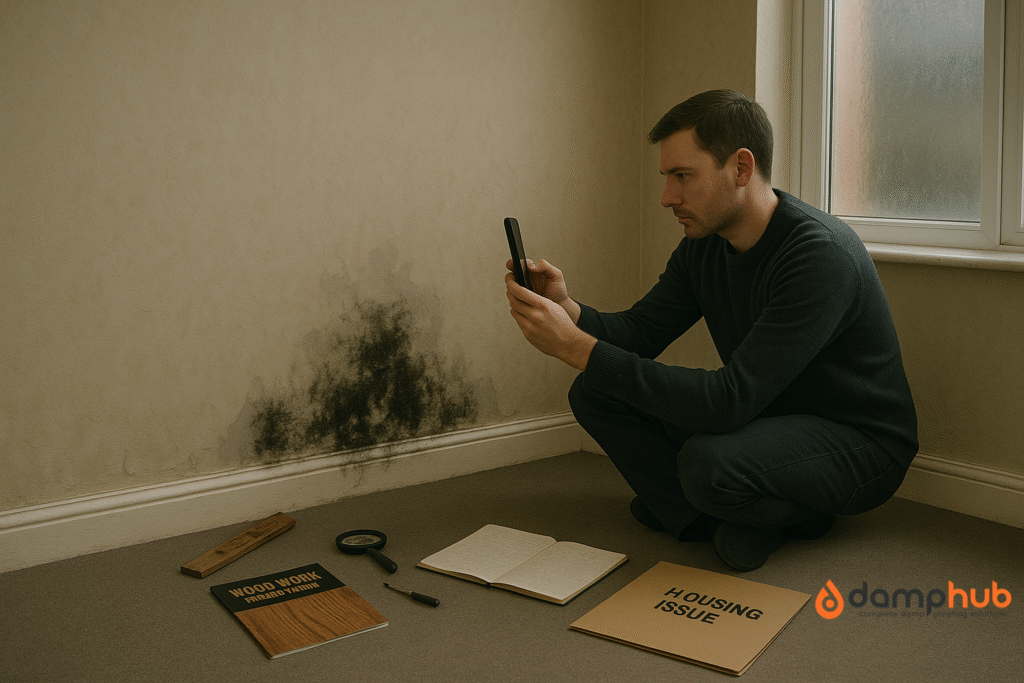
If damp or mould has made your rented home unsafe, uncomfortable, or unlivable, you may be entitled to claim compensation between 25% and 50% of the rent paid during the period of disrepair
Whether your belongings were damaged, your health suffered, or you lost the use of a room, the law is on your side.
This guide explains exactly:
- What’s the damp and mould compensation in the UK?
- What the damp and mould compensation covers,
- How to claim your damp and mould compensation in the UK,
- Tips to maximise the compensation, and
- What to do if your landlord is reluctant to act.
What Is Damp and Mould Compensation?
Damp and mould compensation is financial support or redress for people whose homes have become unsafe or unhealthy due to damp-related issues.
This usually applies when landlords or property managers neglect their legal duty to carry out repairs after being told about the problem.
Damp and mould claims fall under UK housing disrepair law. If you’ve suffered damage to your health, property, or quality of life because of damp conditions, you may be entitled to:
- Money to cover damaged belongings or medical costs
- Compensation for inconvenience, stress, or poor living conditions
- Court orders forcing your landlord to carry out urgent repairs
The key is proving that the issue was reported and ignored. That’s where the process begins.
Who Can Claim for Damp and Mould Compensation in the UK?
Are You a Renter?
If you’re a tenant in a private, council, or housing association property, the law is on your side.
Here’s how to check if you qualify:
- Have you reported the problem to your landlord?
- Did they fail to act within a reasonable timeframe (usually 14 to 28 days)?
- Has the mould or damp caused damage to your belongings, affected your health, or made your home uncomfortable to live in?
If you answered yes to these, you could have a valid claim.
In a House Share or HMO?
If you live in a House in Multiple Occupation (HMO), your landlord has extra legal responsibilities.
If they’ve ignored requests or failed to meet basic safety and maintenance standards, you’re entitled to pursue action just like any other tenant.
Shared Ownership or Leaseholder?
Even if you partially own your home, you may still rely on a housing association or building developer to maintain certain areas (like walls, roofs, or ventilation systems).
If they fail to address damp or mould, your claim may go through:
- An NHBC (National House Building Council) warranty (within 10 years of build)
- A disrepair claim under leasehold laws
- Legal action for breach of contract or duty of care
Don’t assume homeownership disqualifies you—you might have more leverage than you think.
What is Included in the Damp and Mould Compensation?
Your total compensation may include:
- General damages – for pain, suffering, and impact on health
- Special damages – for costs of replacing damaged items (beds, clothes, electronics)
- Loss of enjoyment – for the discomfort and inconvenience of living in a damp home
- Rent reduction or refund – if parts of the home were unusable due to mould
- Heating costs – if you had to use extra heating to keep moisture under control
👉 Related Blog: How to Remove Damp from Walls: The Ultimate Guide

How Much Compensation Can You Get for Damp and Mould in the UK?
The compensation you receive depends on the problems you’ve faced because of damp and mould. This could include health issues, damaged belongings, uninhabitable rooms, or additional expenses.
Below is a full breakdown of what issues are covered and how much you can expect to claim for each one.
1. Health Problems (General Damages)
If mould has made you or your family unwell, you can claim for physical and mental health effects.
What’s covered:
- Asthma, coughs, chest infections, allergies
- Skin rashes, eczema flare-ups
- Anxiety, poor sleep, or stress caused by bad living conditions
Typical compensation:
- Mild symptoms with GP proof: £1,000 – £2,000
- Long-term or severe health problems: £3,000 – £6,000+
📝 What to show: GP or hospital letters, prescriptions, records of missed work or school
2. Damaged Belongings (Special Damages)
If damp ruined your items, you can claim for their replacement cost.
What’s covered:
- Furniture: beds, sofas, wardrobes
- Clothes, shoes, school uniforms
- Books, electronics, documents
- Cleaning or pest control costs
Typical compensation:
- Few items (e.g., shoes, books): £300 – £800
- Several large items (e.g., bed, wardrobe): £1,000 – £2,500+
📝 What to show: Item list with values, receipts if possible, and photos of damage
3. Unusable Rooms (Loss of Enjoyment)
If you couldn’t use part of your home because of mould, you can claim for the discomfort and inconvenience.
What’s covered:
- Bedrooms or living areas that were too damp or mouldy to sleep or use
- Having to sleep on the couch or share one room as a family
- Living in cold, musty, or embarrassing conditions
Typical compensation:
- Single room lost (3+ months): £1,000 – £2,000
- Multiple rooms or whole flat impacted: £2,500 – £4,000+
📝 What to show: Photos of affected rooms, timeline of how long they were unusable, landlord reports, or surveyor notes.

4. Rent Refunds for Unlivable Conditions
If damp made your home partly or fully unfit to live in, you may be due a rent rebate.
What’s covered:
- Rooms you couldn’t use for weeks or months
- Temporary moves to another property
- Paying full rent for a home that wasn’t fully usable
Typical compensation:
- 25% rent refund for one room (3 months): £600 (on £800/month rent)
- 50–100% refund for widespread issues: £1,500 – £5,000+
📝 What to show: Rent statements, dates of unusable space, written notices to landlord
5. Extra Heating or Dehumidifying Costs
Damp homes cost more to heat. You can claim for this added expense.
What’s covered:
- Higher energy bills due to damp walls
- Electric heaters used to fight mould
- Cost of dehumidifiers or moisture traps
Typical compensation:
- Higher energy bills over 3–6 months: £200 – £600
- Added dehumidifier or heating device costs: £100 – £300
📝 What to show: Energy bills before and during the issue, receipts for purchases
Summary Table – Typical Compensation by Impact
| Level of Impact | Common Scenarios | Estimated Payout |
| Minor | Small patch of mould, fast repair, no health impact | £750 – £2,500 |
| Moderate | Ongoing mould, health symptoms, and lost items | £2,500 – £5,000 |
| Severe | Long-term exposure, serious illness, and an unlivable space | £5,000 – £15,000+ |
👉 Also find out: How to Damp Proof a House: 7 Practical Tips from Industry Experts
If you’ve experienced more than one of these issues, your claim could be higher, especially if you have medical records and proof of property damage.
Always keep a paper trail and speak to a housing disrepair solicitor for a full case review.
How to Maximise Your Compensation
- Keep a detailed list of all affected items with estimated values
- Request written confirmation from your GP or local health authority
- Record the duration of the problem and any missed work, disrupted routines, or emotional distress
- Take time-stamped photos to document severity and progression
If you’re unsure about your potential compensation amount, speak to a specialist solicitor. Many offer free case assessments.
What Affects the Amount of Compensation?
The value of your damp and mould compensation claim depends on more than just the presence of mould.
These key factors influence how much you’re likely to receive — and how strong your case will be in court or negotiation.
1. How Long did the Problem last
Courts take the duration seriously. If mould or damp was left for weeks or even months after you reported it, that builds a stronger case.
Long-term exposure often means deeper health effects, more disruption, and higher compensation. Keep a timeline showing when you first noticed the issue and when (or if) anything was done.
2. How Your Landlord Responded
A landlord who acts late — or not at all — puts themselves at legal risk. If you made them aware of the problem and they ignored it, delayed action, or offered only quick fixes, that works in your favour.
Save every message or email as evidence. Negligence is one of the biggest factors that push compensation amounts upward.
3. How Your Health Was Affected
Damp-related health issues like breathing problems, skin irritation, or even stress are all valid parts of a claim. Medical evidence gives your case credibility, especially if symptoms got worse over time.
The stronger your link between health problems and the condition of your home, the higher your claim is likely to go.

4. How It Affected Daily Life
Losing access to a room, being forced to sleep in cramped spaces, or constantly living in cold, damp air takes a toll.
These aren’t just minor inconveniences — they affect your wellbeing, routines, and even mental health. The more disruption to your living conditions, the more weight your claim carries.
5. What You’ve Lost Financially
If you’ve had to throw out mouldy clothes, buy new bedding, run heaters constantly, or even stay elsewhere, these are financial losses you can recover.
Courts often look for proof — receipts, photos, or energy bills — to calculate how much you’ve spent or lost. Every documented cost adds to your final payout.
How to Claim for Damp and Mould Compensation (Step-by-Step)
If your home has been affected by damp and mould and your landlord failed to fix the issue, you may be able to claim compensation.
Here’s how to claim your damp and mould compensation:
1. Notify Your Landlord in Writing
Always report the issue formally, using email or a dated letter. Describe the problem, location, and how it’s affecting your health or living conditions.
Include photos and ask for a written response within 14 days. Without written proof, your case may be harder to argue.
Good to Know: Verbal complaints or text messages usually don’t hold much weight — stick to email or post for a traceable record.
2. Start Collecting Evidence
Document everything as soon as the problem starts. Take regular photos of mould patches, flaking paint, or soaked furniture.
Keep receipts for costs like cleaning supplies or replacement items. If you’ve had health symptoms, ask your GP to confirm the link to poor housing conditions.
Pro Tip: Keep a simple journal noting symptoms, missed work or school days, and any interactions with your landlord.
3. Allow Time for the Landlord to Fix It
Your landlord has a legal duty to act within a reasonable time once the issue is reported. For general damp, the expected window is 14–28 days. But if there’s mould, leaks, or health risks, they’re expected to respond much faster.
Good to Know: Failing to act within this timeframe — especially when health or safety is at risk — can strengthen your compensation claim.
4. Involve the Council If Nothing Happens
If the landlord refuses to deal with the issue, contact your local council’s Environmental Health Team. They can inspect your home and issue a legal enforcement notice if it’s classed as hazardous.
Pro Tip: Council inspection reports carry legal weight and can be a powerful piece of evidence in your case.
👉 Also find out: Best Mould Removers for Walls: How to Remove Mould From the Wall?
5. Speak to a Housing Disrepair Solicitor
If nothing changes, speak to a solicitor who specialises in housing disrepair claims. Most offer no-win, no-fee agreements. They can review your case, contact your landlord legally, and guide you through the next steps.
Good to Know: You usually don’t need to pay anything upfront — legal fees are recovered if you win.
6. Proceed With a Legal Claim
Your solicitor will help file the claim, using all the evidence you’ve collected. Claims usually cover health problems, lost or damaged items, rent refunds, and extra expenses. If your case is strong, most landlords settle without going to court.
Pro Tip: Claims are often resolved in weeks if you’ve kept thorough records and given your landlord the chance to fix things.

Know Your Rights: Tenants and Damp in UK Homes
By law, your landlord must keep your home in a safe, livable condition. Under the Homes (Fitness for Human Habitation) Act 2018, which includes preventing or fixing damp and mould.
This applies to all tenancies under 7 years.
They must maintain:
- The building’s structure and exterior
- Heating, hot water, and ventilation
- Safe internal conditions (e.g., no mould on walls or ceilings)
If they fail, you have a legal path to compensation.
What If My Landlord Won’t Do Anything?
If your landlord is ignoring the problem, you’re not stuck. UK law protects tenants living in unsafe or poorly maintained homes, and there are formal steps you can take to get things moving.
1. Keep Paying Your Rent
Even if your home is in poor condition, don’t stop paying rent. Missing payments could lead to eviction or damage your chances in court. Rent payments and property condition are treated as separate issues under tenancy law.
2. Report the Issue to the Council
When a landlord doesn’t respond to written complaints, your next step is your local council’s Environmental Health Team.
They can inspect the property and issue a formal notice ordering your landlord to carry out repairs. This gives your complaint legal weight.
Good to know: These teams prioritise damp and mould cases, especially when health is at risk.
👉 Related Blog: How to Damp Proof a House: 7 Practical Tips from Industry Experts
3. Seek Help from Housing Advice Services
Organisations like Shelter, Citizens Advice, or local housing charities can provide support, legal guidance, and help you prepare letters or evidence.
Their advice is free and especially useful if you’re unsure how to escalate the issue.
4. Gather More Evidence
If your landlord delays or denies the problem, keep updating your records. Take regular photos, keep track of symptoms, and document how the issue affects your home life.
Strong, dated evidence makes a major difference in legal proceedings.

5. Get Legal Support from a Solicitor
If nothing changes after council involvement, speak to a housing disrepair solicitor. Most work on a no-win, no-fee basis.
They’ll review your case, send formal notices to your landlord, and handle your compensation claim from start to finish.
Tenant Responsibilities
Tenants share some responsibility in preventing damp and mould.
While landlords must handle structural issues, tenants are expected to help reduce moisture and maintain cleanliness.
- Ventilation: Open windows and use extractor fans during cooking, showering, or drying clothes to reduce humidity.
- Heating: Maintain consistent temperatures to prevent condensation. Report any heating issues promptly.
- Cleanliness: Regular cleaning with mould-killing products prevents growth on damp surfaces.
- Reporting: Notify landlords immediately if damp or mould appears. Early action helps avoid bigger problems.
- Drying Indoors: Avoid drying clothes without ventilation. Use a dehumidifier if needed.
When the Landlord May Not Be at Fault
In some cases, the landlord may not be liable for damp and mould, especially when the cause relates to tenant behaviour or unavoidable factors.
- Tenant Negligence: Failing to ventilate or consistently drying clothes indoors can lead to mould.
- Delayed Reporting: If tenants don’t report the issue in time, landlords may not be held fully responsible.
- Poor Housekeeping: Mould can grow due to unclean conditions like wet clothes left out or dirty surfaces.
- Uncontrollable Events: Extreme weather or flooding can cause damp outside the landlord’s control.
Final Thoughts: Don’t Suffer in Silence
You don’t have to live with mould, damp, or landlord neglect. If your health, home, or peace of mind has suffered, it’s time to take action. The process might seem intimidating, but you’re not alone. Start with simple steps:
- Write to your landlord
- Gather your evidence
- Speak to a professional who can help
Get Help Today
Don’t wait for things to get worse.
Talk to a solicitor who handles damp and mould compensation in the UK and find out what you could claim.
The sooner you act, the sooner your home and health can be protected.
FAQs
How to make a damp and mould claim for compensation?
Report the issue to your landlord, keep detailed records (photos, health symptoms, communication), and seek legal help if they fail to act.
You may be entitled to compensation for health effects, inconvenience, or property damage.
How do you detect mould?
Look for black or green patches, a musty smell, peeling paint, condensation, or worsening allergies.
A damp meter or survey can confirm hidden mould.
How do you fight damp and mould?
Ventilate daily, use extractor fans or a dehumidifier, heat the home consistently, clean affected areas, and avoid drying clothes indoors without ventilation.
Report any leaks or structural issues to the landlord.
How do you prove damp?
Take dated photos, record humidity levels, keep communication with your landlord, and get medical or survey reports to support your claim.
How long does my landlord have to fix damp and mould issues?
Usually within 14 days for general issues, and 24–72 hours for urgent or health-related problems.
What is the maximum compensation for housing disrepair?
Up to 100% of rent if the home is uninhabitable (rare).
Most claims range from 25% to 50%, depending on how severe and long-lasting the problem is.
How to sue a landlord for damp and mould?
Gather evidence, send a formal complaint, and contact a housing solicitor.
If ignored, file a disrepair claim in court or through the Housing Ombudsman.






